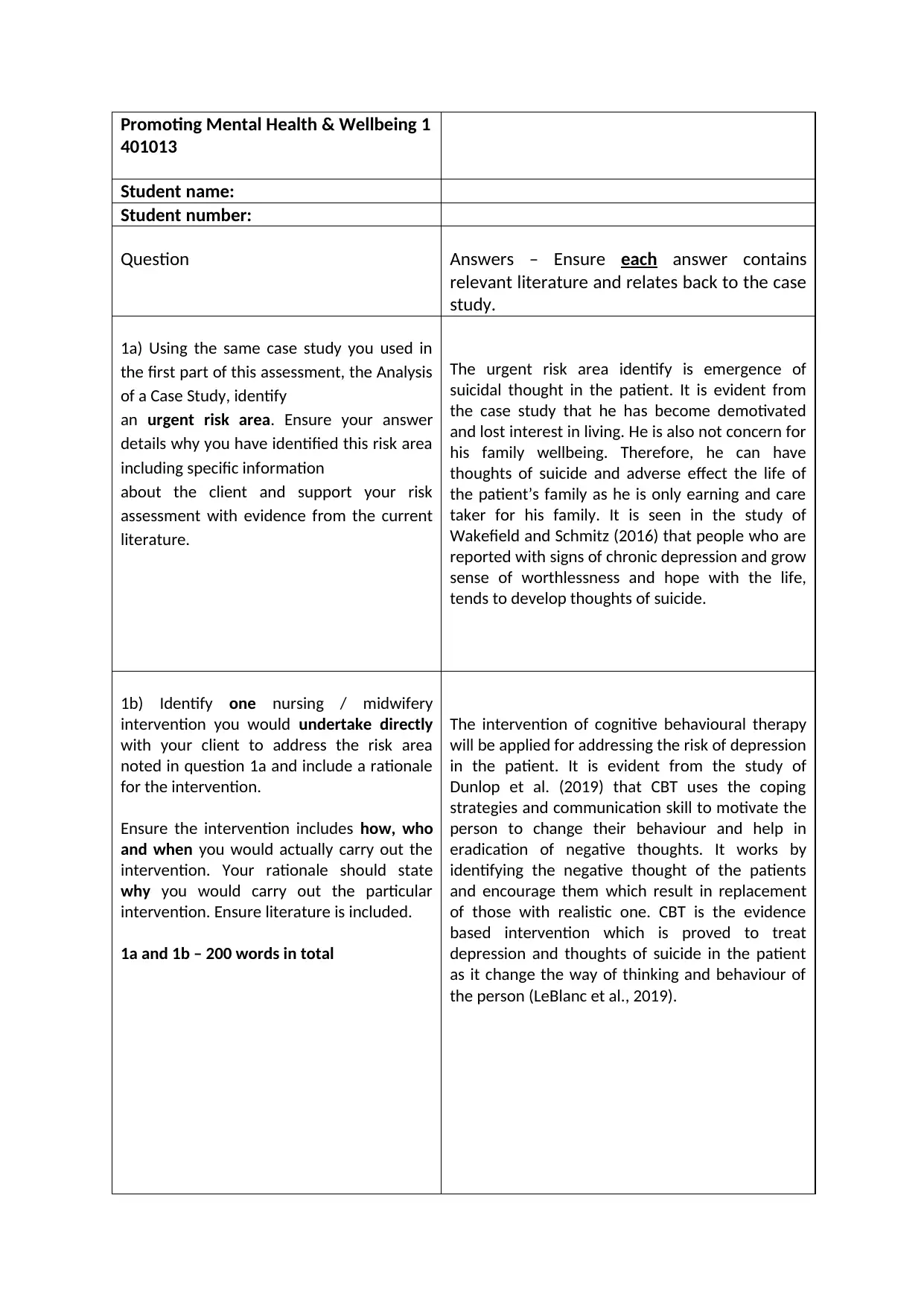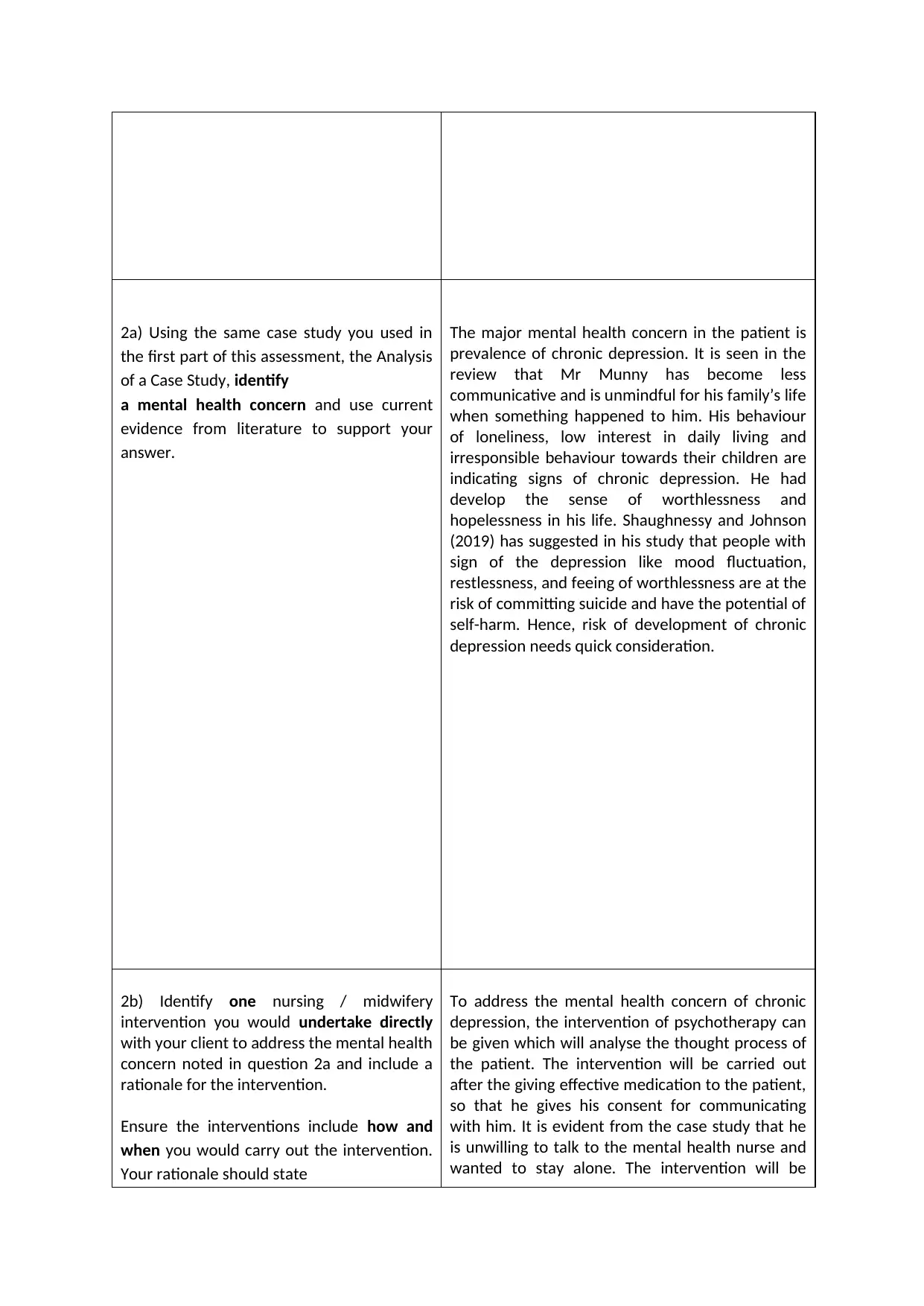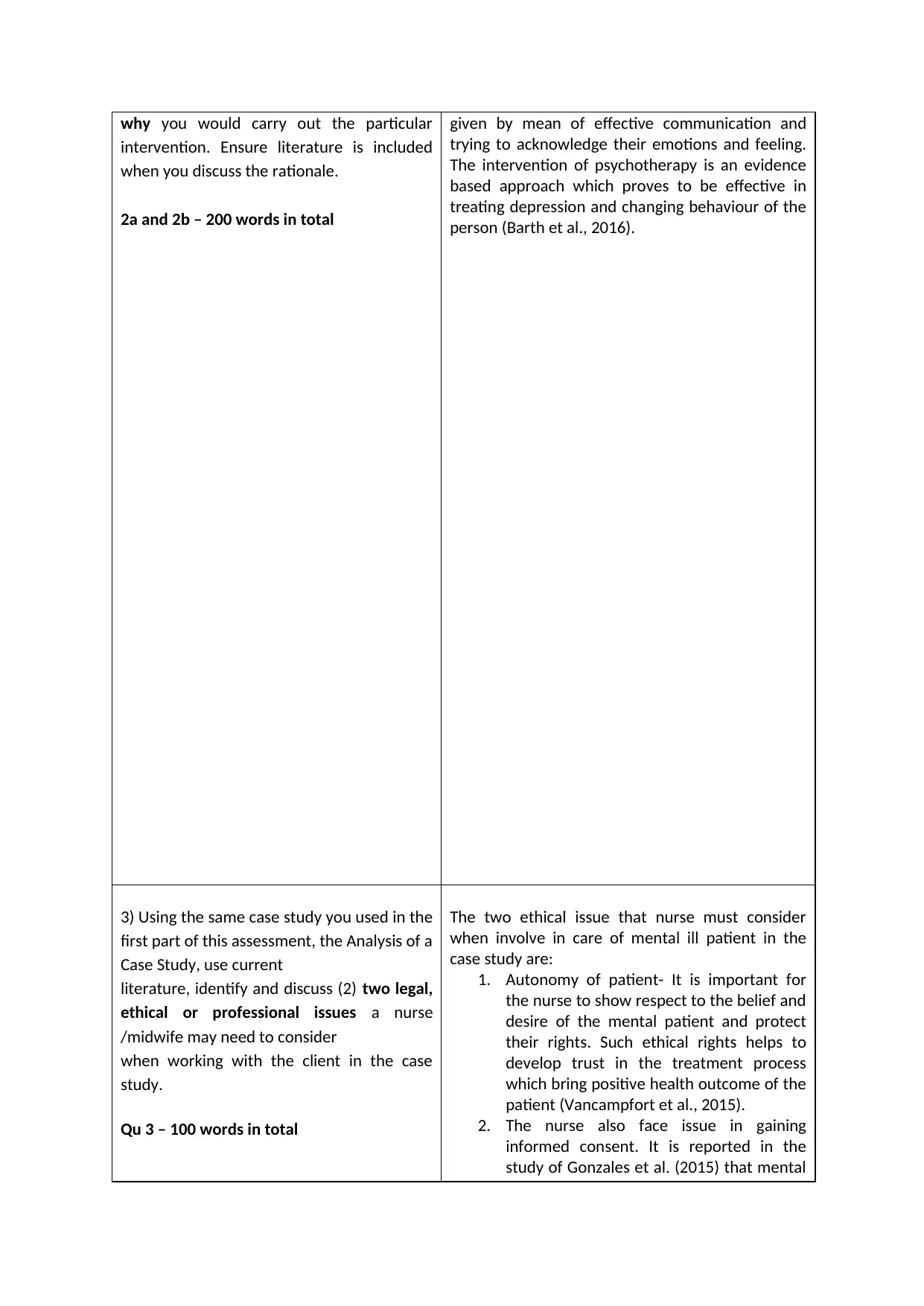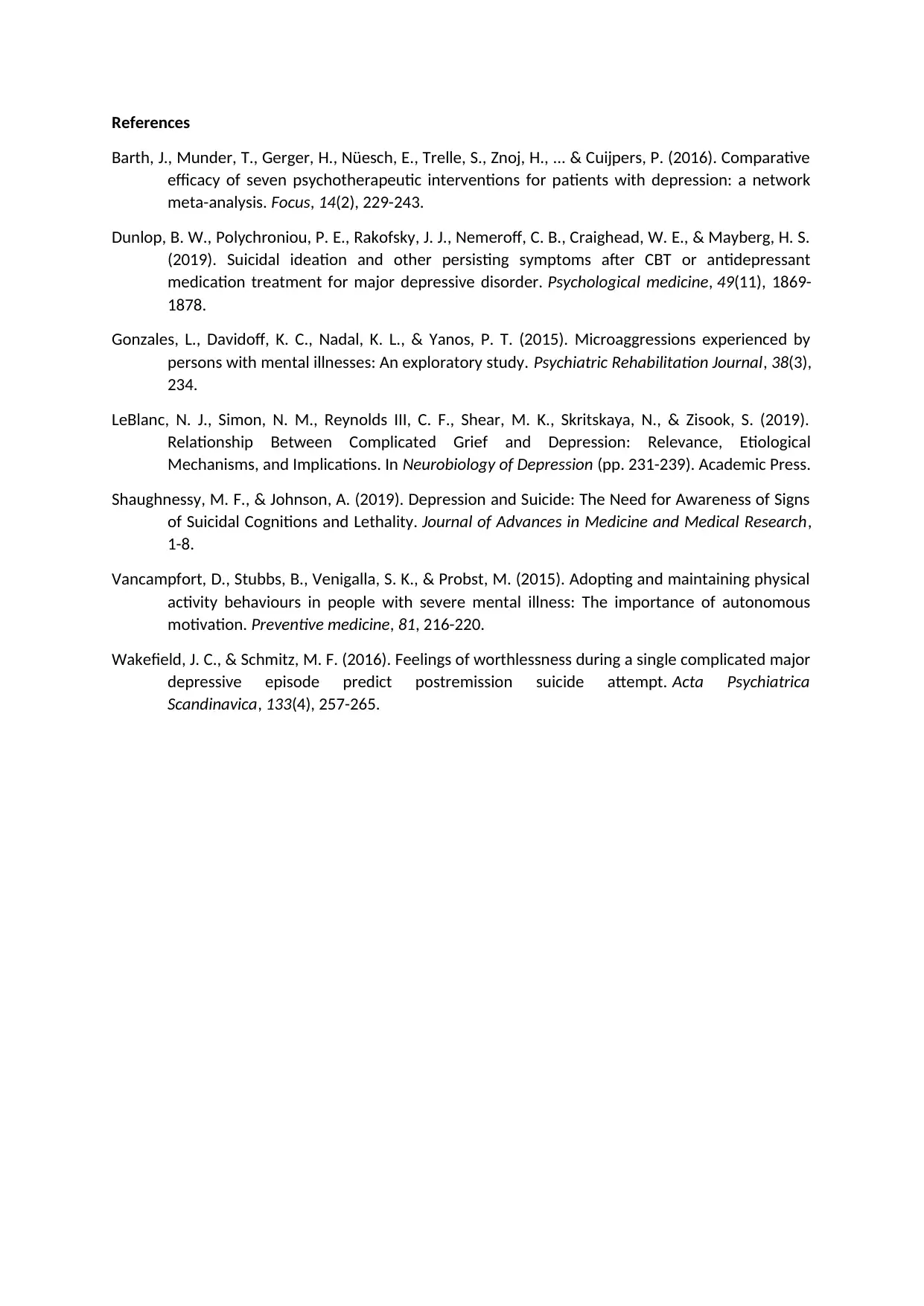401013 Mental Health Risk Assessment and Intervention Strategies
VerifiedAdded on 2022/09/18
|5
|1344
|18
Homework Assignment
AI Summary
This assignment analyzes a case study of a patient exhibiting signs of mental health concerns, including suicidal ideation and chronic depression. The student identifies an urgent risk area, specifically the emergence of suicidal thoughts, supporting the assessment with evidence from literature and suggesting cognitive behavioral therapy (CBT) as an intervention. The assignment also highlights the mental health concern of chronic depression and proposes psychotherapy as a treatment approach. Furthermore, it discusses two ethical issues, patient autonomy, and gaining informed consent, that nurses must consider. The analysis is supported by current literature and addresses legal, ethical, and professional considerations for nurses and midwives involved in the patient's care. The assignment follows the given criteria by addressing risk, interventions, and ethical considerations, with references to support arguments.

Promoting Mental Health & Wellbeing 1
401013
Student name:
Student number:
Question Answers – Ensure each answer contains
relevant literature and relates back to the case
study.
1a) Using the same case study you used in
the first part of this assessment, the Analysis
of a Case Study, identify
an urgent risk area. Ensure your answer
details why you have identified this risk area
including specific information
about the client and support your risk
assessment with evidence from the current
literature.
The urgent risk area identify is emergence of
suicidal thought in the patient. It is evident from
the case study that he has become demotivated
and lost interest in living. He is also not concern for
his family wellbeing. Therefore, he can have
thoughts of suicide and adverse effect the life of
the patient’s family as he is only earning and care
taker for his family. It is seen in the study of
Wakefield and Schmitz (2016) that people who are
reported with signs of chronic depression and grow
sense of worthlessness and hope with the life,
tends to develop thoughts of suicide.
1b) Identify one nursing / midwifery
intervention you would undertake directly
with your client to address the risk area
noted in question 1a and include a rationale
for the intervention.
Ensure the intervention includes how, who
and when you would actually carry out the
intervention. Your rationale should state
why you would carry out the particular
intervention. Ensure literature is included.
1a and 1b – 200 words in total
The intervention of cognitive behavioural therapy
will be applied for addressing the risk of depression
in the patient. It is evident from the study of
Dunlop et al. (2019) that CBT uses the coping
strategies and communication skill to motivate the
person to change their behaviour and help in
eradication of negative thoughts. It works by
identifying the negative thought of the patients
and encourage them which result in replacement
of those with realistic one. CBT is the evidence
based intervention which is proved to treat
depression and thoughts of suicide in the patient
as it change the way of thinking and behaviour of
the person (LeBlanc et al., 2019).
401013
Student name:
Student number:
Question Answers – Ensure each answer contains
relevant literature and relates back to the case
study.
1a) Using the same case study you used in
the first part of this assessment, the Analysis
of a Case Study, identify
an urgent risk area. Ensure your answer
details why you have identified this risk area
including specific information
about the client and support your risk
assessment with evidence from the current
literature.
The urgent risk area identify is emergence of
suicidal thought in the patient. It is evident from
the case study that he has become demotivated
and lost interest in living. He is also not concern for
his family wellbeing. Therefore, he can have
thoughts of suicide and adverse effect the life of
the patient’s family as he is only earning and care
taker for his family. It is seen in the study of
Wakefield and Schmitz (2016) that people who are
reported with signs of chronic depression and grow
sense of worthlessness and hope with the life,
tends to develop thoughts of suicide.
1b) Identify one nursing / midwifery
intervention you would undertake directly
with your client to address the risk area
noted in question 1a and include a rationale
for the intervention.
Ensure the intervention includes how, who
and when you would actually carry out the
intervention. Your rationale should state
why you would carry out the particular
intervention. Ensure literature is included.
1a and 1b – 200 words in total
The intervention of cognitive behavioural therapy
will be applied for addressing the risk of depression
in the patient. It is evident from the study of
Dunlop et al. (2019) that CBT uses the coping
strategies and communication skill to motivate the
person to change their behaviour and help in
eradication of negative thoughts. It works by
identifying the negative thought of the patients
and encourage them which result in replacement
of those with realistic one. CBT is the evidence
based intervention which is proved to treat
depression and thoughts of suicide in the patient
as it change the way of thinking and behaviour of
the person (LeBlanc et al., 2019).
Paraphrase This Document
Need a fresh take? Get an instant paraphrase of this document with our AI Paraphraser

2a) Using the same case study you used in
the first part of this assessment, the Analysis
of a Case Study, identify
a mental health concern and use current
evidence from literature to support your
answer.
The major mental health concern in the patient is
prevalence of chronic depression. It is seen in the
review that Mr Munny has become less
communicative and is unmindful for his family’s life
when something happened to him. His behaviour
of loneliness, low interest in daily living and
irresponsible behaviour towards their children are
indicating signs of chronic depression. He had
develop the sense of worthlessness and
hopelessness in his life. Shaughnessy and Johnson
(2019) has suggested in his study that people with
sign of the depression like mood fluctuation,
restlessness, and feeing of worthlessness are at the
risk of committing suicide and have the potential of
self-harm. Hence, risk of development of chronic
depression needs quick consideration.
2b) Identify one nursing / midwifery
intervention you would undertake directly
with your client to address the mental health
concern noted in question 2a and include a
rationale for the intervention.
Ensure the interventions include how and
when you would carry out the intervention.
Your rationale should state
To address the mental health concern of chronic
depression, the intervention of psychotherapy can
be given which will analyse the thought process of
the patient. The intervention will be carried out
after the giving effective medication to the patient,
so that he gives his consent for communicating
with him. It is evident from the case study that he
is unwilling to talk to the mental health nurse and
wanted to stay alone. The intervention will be
the first part of this assessment, the Analysis
of a Case Study, identify
a mental health concern and use current
evidence from literature to support your
answer.
The major mental health concern in the patient is
prevalence of chronic depression. It is seen in the
review that Mr Munny has become less
communicative and is unmindful for his family’s life
when something happened to him. His behaviour
of loneliness, low interest in daily living and
irresponsible behaviour towards their children are
indicating signs of chronic depression. He had
develop the sense of worthlessness and
hopelessness in his life. Shaughnessy and Johnson
(2019) has suggested in his study that people with
sign of the depression like mood fluctuation,
restlessness, and feeing of worthlessness are at the
risk of committing suicide and have the potential of
self-harm. Hence, risk of development of chronic
depression needs quick consideration.
2b) Identify one nursing / midwifery
intervention you would undertake directly
with your client to address the mental health
concern noted in question 2a and include a
rationale for the intervention.
Ensure the interventions include how and
when you would carry out the intervention.
Your rationale should state
To address the mental health concern of chronic
depression, the intervention of psychotherapy can
be given which will analyse the thought process of
the patient. The intervention will be carried out
after the giving effective medication to the patient,
so that he gives his consent for communicating
with him. It is evident from the case study that he
is unwilling to talk to the mental health nurse and
wanted to stay alone. The intervention will be

why you would carry out the particular
intervention. Ensure literature is included
when you discuss the rationale.
2a and 2b – 200 words in total
given by mean of effective communication and
trying to acknowledge their emotions and feeling.
The intervention of psychotherapy is an evidence
based approach which proves to be effective in
treating depression and changing behaviour of the
person (Barth et al., 2016).
3) Using the same case study you used in the
first part of this assessment, the Analysis of a
Case Study, use current
literature, identify and discuss (2) two legal,
ethical or professional issues a nurse
/midwife may need to consider
when working with the client in the case
study.
Qu 3 – 100 words in total
The two ethical issue that nurse must consider
when involve in care of mental ill patient in the
case study are:
1. Autonomy of patient- It is important for
the nurse to show respect to the belief and
desire of the mental patient and protect
their rights. Such ethical rights helps to
develop trust in the treatment process
which bring positive health outcome of the
patient (Vancampfort et al., 2015).
2. The nurse also face issue in gaining
informed consent. It is reported in the
study of Gonzales et al. (2015) that mental
intervention. Ensure literature is included
when you discuss the rationale.
2a and 2b – 200 words in total
given by mean of effective communication and
trying to acknowledge their emotions and feeling.
The intervention of psychotherapy is an evidence
based approach which proves to be effective in
treating depression and changing behaviour of the
person (Barth et al., 2016).
3) Using the same case study you used in the
first part of this assessment, the Analysis of a
Case Study, use current
literature, identify and discuss (2) two legal,
ethical or professional issues a nurse
/midwife may need to consider
when working with the client in the case
study.
Qu 3 – 100 words in total
The two ethical issue that nurse must consider
when involve in care of mental ill patient in the
case study are:
1. Autonomy of patient- It is important for
the nurse to show respect to the belief and
desire of the mental patient and protect
their rights. Such ethical rights helps to
develop trust in the treatment process
which bring positive health outcome of the
patient (Vancampfort et al., 2015).
2. The nurse also face issue in gaining
informed consent. It is reported in the
study of Gonzales et al. (2015) that mental
⊘ This is a preview!⊘
Do you want full access?
Subscribe today to unlock all pages.

Trusted by 1+ million students worldwide

ill patient does not give their consent for
the therapy or intervention, where they
face difficulty in addressing it. Forceful
action by the nurse have negative effect on
the mental health therefore, it is important
for the nurse to gain consent before
initialising the intervention.
the therapy or intervention, where they
face difficulty in addressing it. Forceful
action by the nurse have negative effect on
the mental health therefore, it is important
for the nurse to gain consent before
initialising the intervention.
Paraphrase This Document
Need a fresh take? Get an instant paraphrase of this document with our AI Paraphraser

References
Barth, J., Munder, T., Gerger, H., Nüesch, E., Trelle, S., Znoj, H., ... & Cuijpers, P. (2016). Comparative
efficacy of seven psychotherapeutic interventions for patients with depression: a network
meta-analysis. Focus, 14(2), 229-243.
Dunlop, B. W., Polychroniou, P. E., Rakofsky, J. J., Nemeroff, C. B., Craighead, W. E., & Mayberg, H. S.
(2019). Suicidal ideation and other persisting symptoms after CBT or antidepressant
medication treatment for major depressive disorder. Psychological medicine, 49(11), 1869-
1878.
Gonzales, L., Davidoff, K. C., Nadal, K. L., & Yanos, P. T. (2015). Microaggressions experienced by
persons with mental illnesses: An exploratory study. Psychiatric Rehabilitation Journal, 38(3),
234.
LeBlanc, N. J., Simon, N. M., Reynolds III, C. F., Shear, M. K., Skritskaya, N., & Zisook, S. (2019).
Relationship Between Complicated Grief and Depression: Relevance, Etiological
Mechanisms, and Implications. In Neurobiology of Depression (pp. 231-239). Academic Press.
Shaughnessy, M. F., & Johnson, A. (2019). Depression and Suicide: The Need for Awareness of Signs
of Suicidal Cognitions and Lethality. Journal of Advances in Medicine and Medical Research,
1-8.
Vancampfort, D., Stubbs, B., Venigalla, S. K., & Probst, M. (2015). Adopting and maintaining physical
activity behaviours in people with severe mental illness: The importance of autonomous
motivation. Preventive medicine, 81, 216-220.
Wakefield, J. C., & Schmitz, M. F. (2016). Feelings of worthlessness during a single complicated major
depressive episode predict postremission suicide attempt. Acta Psychiatrica
Scandinavica, 133(4), 257-265.
Barth, J., Munder, T., Gerger, H., Nüesch, E., Trelle, S., Znoj, H., ... & Cuijpers, P. (2016). Comparative
efficacy of seven psychotherapeutic interventions for patients with depression: a network
meta-analysis. Focus, 14(2), 229-243.
Dunlop, B. W., Polychroniou, P. E., Rakofsky, J. J., Nemeroff, C. B., Craighead, W. E., & Mayberg, H. S.
(2019). Suicidal ideation and other persisting symptoms after CBT or antidepressant
medication treatment for major depressive disorder. Psychological medicine, 49(11), 1869-
1878.
Gonzales, L., Davidoff, K. C., Nadal, K. L., & Yanos, P. T. (2015). Microaggressions experienced by
persons with mental illnesses: An exploratory study. Psychiatric Rehabilitation Journal, 38(3),
234.
LeBlanc, N. J., Simon, N. M., Reynolds III, C. F., Shear, M. K., Skritskaya, N., & Zisook, S. (2019).
Relationship Between Complicated Grief and Depression: Relevance, Etiological
Mechanisms, and Implications. In Neurobiology of Depression (pp. 231-239). Academic Press.
Shaughnessy, M. F., & Johnson, A. (2019). Depression and Suicide: The Need for Awareness of Signs
of Suicidal Cognitions and Lethality. Journal of Advances in Medicine and Medical Research,
1-8.
Vancampfort, D., Stubbs, B., Venigalla, S. K., & Probst, M. (2015). Adopting and maintaining physical
activity behaviours in people with severe mental illness: The importance of autonomous
motivation. Preventive medicine, 81, 216-220.
Wakefield, J. C., & Schmitz, M. F. (2016). Feelings of worthlessness during a single complicated major
depressive episode predict postremission suicide attempt. Acta Psychiatrica
Scandinavica, 133(4), 257-265.
1 out of 5
Related Documents
Your All-in-One AI-Powered Toolkit for Academic Success.
+13062052269
info@desklib.com
Available 24*7 on WhatsApp / Email
![[object Object]](/_next/static/media/star-bottom.7253800d.svg)
Unlock your academic potential
Copyright © 2020–2025 A2Z Services. All Rights Reserved. Developed and managed by ZUCOL.




